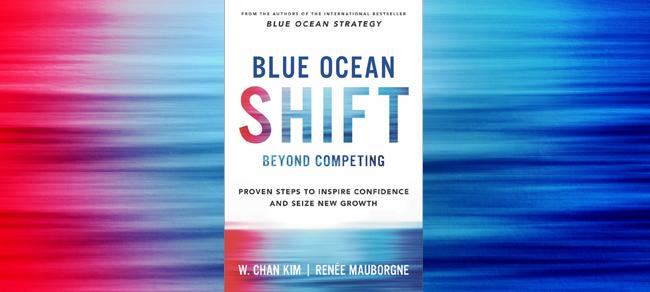
INSEAD Knowledge: Blue ocean strategy is very popular among MBA students. What value or benefit does blue ocean strategy create for MBA students? In other words, how does focusing on blue ocean strategy strengthen the skillset of the MBAs as they enter the job market?
Kim & Mauborgne: We see strengths for MBAs who focus on blue ocean strategy based on the trajectory of where the global economy is moving. Today organisations all over the world face intense competition, shrinking profit margins, and declining brand power. As competitive pressure continues to heighten, understanding how organisations can break away from the competition and achieve differentiation and lower costs becomes increasingly key. In this way, blue ocean strategy, which provides students with a strategic logic, tools, and frameworks to directly address this challenge, strengthens the value MBAs can bring to organisations.
Beyond the red oceans of known market space that most companies fight intensely over, blue ocean strategy highlights the possibility and the process and methodology to create blue oceans of new market space - skills that we believe are increasingly indispensable for MBAs and executives today and in the future.
INSEAD Knowledge: Are there any specific industries or types of employers that are particularly keen on hiring jobseekers with a blue ocean strategy background?
Kim & Mauborgne: In 2014 we received the Carl S. Sloane Award for Excellence in Management Consulting due to the impact Blue Ocean Strategy has had on the consulting industry. So we guess that in itself says something. However, the point we keep coming back to is that blue ocean strategy is increasingly critical in almost all industries. Whether it’s healthcare, financial services, the construction industry, consumer electronics, the non-profit sector or the furniture industry almost all are up against a red ocean of bloody competition and need to get out.
For MBAs aiming to create start-ups, blue ocean strategy is equally valuable. Consider the U.S. where only 50% of start-ups survive beyond five years and less than 20% survive more than ten years. To significantly raise these odds, start-ups need to understand how to simultaneously achieve differentiation and low costs in order to stand apart and create a new customer base.
Peter Zemsky, Dean for Strategic Initiative and Innovation, recently pointed out to us how blue ocean strategy is particularly valuable in this light: “I just saw a former MBA student who raised $100M for his start-up and I asked him what he remembered from the strategy course a few years ago. The first thing he flagged was blue ocean strategy”. Employers in most sectors and industries today are looking for fresh thinking. They are striving for ways to break away from the competition while lowering costs, and are seeking to stimulate new demand. They are also in search of processes, tools and methodologies to achieve this. That makes employers across sectors increasingly receptive to MBAs with a background in Blue Ocean Strategy. It is our hope, and the reason why we have dedicated more than twenty years to this topic, that through these ideas and frameworks, MBAs and executives will be able to make an even greater contribution to improving the state of the world, shifting organisations out of red ocean of bloody competition into the blue ocean of new market space.
INSEAD Knowledge: Blue ocean strategy has become an integral part of the MBA and executive education programmes here at INSEAD with no less than fourteen faculty members teaching Blue Ocean Strategy in a variety of courses. Can you tell us what options are offered at INSEAD for executives to learn and apply blue ocean strategy in practice in their organisations?
Kim & Mauborgne: At the executive level, INSEAD offers a great array of programmes. Currently the school runs a total of 15 dedicated Blue Ocean Strategy programmes. These include the INSEAD Blue Ocean Strategy open enrolment programme, offered three times a year, and 11 Blue Ocean Strategy customised programmes. These programmes are held on the school’s three campuses - Fontainebleau, Singapore, and Abu Dhabi as well as around the world from Germany to Denmark, Russia, the US, Australia, China, Brazil, Saudi Arabia, and Nigeria. In 2009 the French economic and management magazine L’ Expansion selected the Blue Ocean Strategy open enrolment programme as one of the top 10 executive programmes offered by business schools. In addition to the dedicated executive programmes, Blue Ocean Strategy is also taught in over 100 sessions in more than 50 other INSEAD executive education programmes.
INSEAD Knowledge: Blue ocean strategy has had a significant impact on the MBA curriculum at INSEAD. Which blue ocean strategy courses are offered for MBAs at INSEAD?
Kim & Mauborgne: At the MBA level, beyond being introduced in the core strategy course, INSEAD offers dedicated Blue Ocean Strategy electives, including the Blue Ocean Strategy Theory and Simulation Course, and the Blue Ocean Strategy Study Group.
The Blue Ocean Strategy Theory and Simulation Course focuses on the key conceptual blocks and analytic tools underpinning blue ocean strategy, as well as offers students a platform to test their blue ocean strategy logic through a business simulation. The Blue Ocean Strategy Study Group gives participants the opportunity to then apply these concepts in independent research projects of the participants’ own choosing under our personal guidance. Participants who successfully complete the blue oceans strategy courses are granted a Blue Ocean Strategy Certificate issued by the INSEAD Blue Ocean Strategy Institute.
Taken together these courses are complementary, preparing MBA participants with the knowledge, tools and experience for breaking away from the competition and creating new market space in the real business world after graduation.
INSEAD Knowledge: Blue ocean strategy executive education courses almost always seem to be oversubscribed. Can you comment on why blue ocean strategy is so popular with executives at INSEAD?
Kim & Mauborgne: Blue ocean strategy addresses one of the key challenges that executives face. Nearly everybody is hitting a wall when it comes to productivity. Companies have been successfully squeezing inefficiencies out of their businesses. But that can only take an organisation so far. As Peter Zemsky, Dean for Strategic Initiative and Innovation at INSEAD, powerfully argues, “At some point companies fundamentally have to find new opportunities for growth. Even very successful companies, for example, often find themselves stuck in a number 2 or 3 position. The question they have is: How do we challenge industry leadership to become number one? The strength of blue ocean strategy is that it provides a systematic way to address these challenges.”
Mark Roberts, Associate Dean of Executive Education Programmes at INSEAD recently noted that “blue ocean strategy is really a key pillar in much of the value that we aim to bring to executives”, in that it helps companies build innovation cultures and think about their businesses and industries in a completely different way.
INSEAD Knowledge: INSEAD is the intellectual home of blue ocean strategy, but the theory is being taught and applied far beyond that. Why should or shouldn't other schools adopt blue ocean strategy in their curriculums?
Kim & Mauborgne: We very much welcome other schools adopting blue ocean strategy in their curriculum as it strengthens the INSEAD global brand and showcases INSEAD’s global thought leadership. This also clarifies that INSEAD is the intellectual home of blue ocean strategy. While every region and county of the world has challenges unique to it, almost all are feeling the sting of the global economic trajectory we just discussed. One indicator of this is that Blue Ocean Strategy is a bestseller across five continents and is published in a record-breaking 44 languages. For us this suggests that teaching blue ocean strategy and adopting it as part of other schools’ curriculum would allow them to better meet the growing demands of the marketplace.
In fact, we are seeing just that. Currently, Blue Ocean Strategy pedagogical materials developed by the INSEAD Blue Ocean Strategy Institute are being used by over 1,800 universities in more than 100 countries. To share our research and teaching experiences and practices with other schools, our website blueoceanstrategy.com has a section devoted to teaching materials that provides all the cases, theory-based videos, teaching notes, lecture slides, free to download apps, and Blue Ocean Strategy course syllabi which any university can use to build it into their curriculum.
INSEAD Knowledge: The Blue Ocean Strategy book continues to be extremely popular, now approaching 4 million sales worldwide. This year the expanded edition came out and you just signed on 44th language, Georgian. That’s an amazing achievement and we, at INSEAD, are proud to share in this success. Can you tell us a bit about the expanded edition and how it differs from the original one?
Kim & Mauborgne: Indeed this year has been very special to us, as we launched a new edition of Blue Ocean Strategy. In addition to bringing all of the original case studies and examples up to date, we expanded it in three key ways that reflects some of the most dominant questions received on the ideas over the last decade. First, we added a new chapter on alignment – what it means, why it’s essential, and how to achieve it. In the expanded edition we provide a simple but comprehensive method to ensure that the key components of an organisation, from value to profit to people, are aligned to support the strategic shift blue ocean strategy requires.
Second, we significantly expanded our discussion on when and how to renew blue oceans over time. Understanding the process of renewal is key to ensure that the creation of blue oceans is not a one-off occurrence, but can be institutionalised as a repeatable process in an organisation. In the expanded edition, we tackle how leaders can turn the creation of blue oceans from a static achievement into a dynamic renewal process both at the business level and at the corporate level for multi-business firms.
Lastly, we created a new chapter on the red ocean traps we see companies fall into as they put blue ocean strategy in practice. These traps keep companies anchored in the red even as they attempt to set sail for the blue. Addressing these traps is critical to getting people’s framing right to create blue oceans.
INSEAD Knowledge: The New York Times recently mentioned that you are working on a next book. What will this be about? Can you give us a glimpse?
Kim & Mauborgne: We are very excited about our next book. While we are not privileged to go into detail at this moment, what we can share is that the book will have conceptual punch and make what we believe will be a strong theoretical contribution to the study of growth and profit. We will, for example, talk about how to expand the economic pie beyond creative destruction, thus challenging Schumpeter’s classic theory. This will have implications for economic growth and job creation, two major concerns at both the micro-economic level of the firm and the macro-economic level of the economy and government policy. With that new conceptual understanding we will then drop down to the level of practice and bridge the gap between theory and action by explaining step-by-step what it really takes to shift from a red ocean into a blue one whether you are an established company, a nonprofit, a startup or a government agency.
INSEAD Knowledge: Sounds like you are on the path towards creating a next global bestseller. Thank you for your time.
About the series
-
View Comments
(2) -
Anonymous User
I have been thinking about enrolling in business school for a while but was unsure which school would be the right fit. This article really inspired me to look into INSEAD and its blue ocean strategy courses. Thanks!
-
Leave a Comment






Anonymous User
21/12/2015, 05.38 pm
As a MBA student, I think that this article really hit the nail on the head. Blue Ocean Strategy is so important today and I think more schools should incorporate it into their curriculums! Thanks for this article!